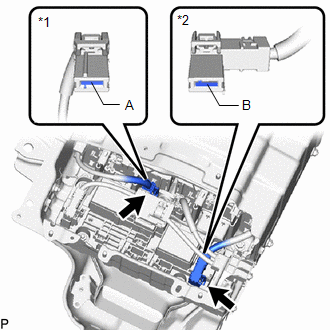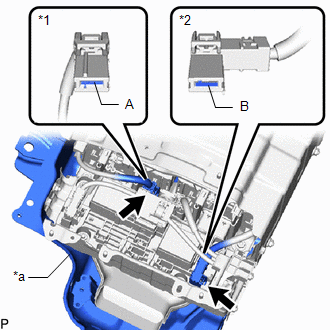| Last Modified: 01-30-2024 | 6.11:8.1.0 | Doc ID: RM100000001OE61 |
| Model Year Start: 2020 | Model: RAV4 HV | Prod Date Range: [06/2020 - ] |
| Title: HYBRID / BATTERY CONTROL: HV BATTERY (for LITHIUM-ION BATTERY): RECOVERY INSPECTION; 2020 - 2024 MY RAV4 HV [06/2020 - ] | ||
|
RECOVERY INSPECTION |
CAUTION / NOTICE / HINT
CAUTION:
- When disposing of an HV battery, make sure to return it through an authorized collection agent who is capable of handling it safely. If the HV battery is returned via the manufacturer specified route, it will be returned properly and in a safe manner by an authorized collection agent.
- Before returning the HV battery, make sure to perform a pre-return inspection.
-
Accidents such as electric shock may result if the HV battery is discharged improperly and disposed or abandoned.
Therefore, make sure to return the HV battery through an authorized collection agent.
- To reduce the risk of fire, HV battery must not be stored in an area where they will be exposed to fire or high temperatures.
- If the temperature of the HV battery is high, leave it to cool down.
HINT:
In order to return the HV battery in a safe manner, it may be necessary to discharge it. The following pre-return inspection procedure can be used to determine whether or not it is necessary to discharge the HV battery the method that may be required.
PROCEDURE
|
1. |
INSPECT FOR ELECTROLYTE LEAK |
CAUTION:
Be sure to wear insulated gloves and protective goggles.
|
(a) Position the HV battery as shown in the illustration and leave it for 5 minutes. |
|
(b) Check that no electrolyte is leaking from the HV battery.
OK:
There is no electrolyte leaking from the HV battery.
CAUTION:
- Perform this procedure in an area where the battery will not be exposed to fire.
- Do not touch the HV battery, unless absolutely necessary, as electrolyte may be leaking.
NOTICE:
If there is an electrolyte leak, make sure to wear insulated gloves and goggles and clean it using a piece of cloth. Do not leave electrolyte-contaminated cloths unattended. Dispose of them according to law or local regulations.
| NG |

|
DISCHARGING (WHEN USING THE SALT WATER SOLUTION) |
|
|
2. |
CHECK FOR DTCS |
(a) Check the previously recorded DTCs which resulted in replacement of the HV battery.
|
Result |
Proceed to |
|---|---|
|
DTC record not available. |
A |
|
The HV battery was replaced due to a reason other than the DTCs listed in the following table. |
B |
|
The HV battery was replaced due to one of the DTCs listed in the following table. |
C |
|
DTC No. |
|---|
|
P1A6017 |
|
P31AA17 |
|
P0C3000 |
|
P31B300 |
|
P1C7D49 |
| B |

|
| C |

|
|
|
3. |
CHECK HV BATTERY VOLTAGE |
CAUTION:
Be sure to wear insulated gloves.
|
(a) Measure the voltage according to the value(s) in the table below. Standard Voltage:
CAUTION: Make sure not to cross the probes of the electrical tester. |
|
| NG |

|
|
|
4. |
INSULATION INSPECTION OF HV BATTERY |
CAUTION:
Be sure to wear insulated gloves.
|
(a) Using a megohmmeter set to 500 V, measure the insulation resistance according to the value(s) in the table below. NOTICE: Be sure to set the megohmmeter to 500 V when performing this test. Using a setting higher than 500 V can result in damage to the component being inspected. Standard Resistance:
|
|
| NG |

|
|
|
5. |
HV BATTERY VISUAL CHECK |
CAUTION:
Be sure to wear insulated gloves.
(a) Check that the HV battery is not deformed or damaged.
OK:
The HV battery is not deformed or damaged.
| OK |

|
RETURN HV BATTERY |
| NG |

|
|
6. |
HV BATTERY CONNECTORS VISUAL CHECK |
CAUTION:
Be sure to wear insulated gloves and protective goggles.
(a) Check that the orange connectors connected to the battery ECU assembly are not deformed or damaged.
OK:
The connectors are not deformed or damaged.
HINT:
If any of the connectors are damaged, a Li-ion battery discharger will not be able to be connected to the HV battery. Soak the HV battery in a saltwater solution to discharge it.
| OK |

|
DISCHARGING (WHEN USING THE LI-ION BATTERY DISCHARGER) |
| NG |

|
DISCHARGING (WHEN USING THE SALT WATER SOLUTION) |
|
|
|



